
Courses, Conferences & Tools
Applications in Neurodevelopment: Exploring the relationship between Auditory Processing Disorders and Unintegrated Primary Reflexes
Applications in Neurodevelopment: Exploring the relationship between Auditory Processing Disorders and Unintegrated Primary Reflexes
Though signs and symptoms of Auditory Processing Disorder (APD) are prevalent as young as 6 months of age, formalized testing for APD by audiologists is often deferred until the age of 7-8 years, when the sensitive period for auditory development has signifcantly passed. One reason for delayed APD diagnosis is that tests included in the APD battery often require a more sophisticated language level to comprehend the listening tasks. Furthermore, most tests do not have reliable norms for younger children. We must not wait for formalized testing to begin addressing signs and symptoms of APD. Primary reflex integration is the gateway for development and integration of our sensory system modalities, including hearing, which will be discussed in greater detail.
This lecture explores the two auditory pathways that are active in children: classical and non-classical auditory pathways. It shares how non-classical auditory pathways are related to primary reflex integration and how those pathways connect the hearing, somatosensory and visual systems.
Information on identifying early signs of APD, testing APD, and treatments for different categories of APD will be presented. A look at the relationship between specific unintegrated primary reflexes and APD will be shared by the lecturers, Dr. Leah Light and Dr. Jay Lucker, based on their presentation at the International Guild for Auditory Processing (IGAPS) conference in October 2021.
Lecturers:
Dr. Leah Light, Au.D., MNRI® Core Specialist and Instructor
Dr. Jay Lucker, EDD, CCC-A/SLP, FAAA
Video Runtime: 2 hours, 27 minutes, 39 seconds.




